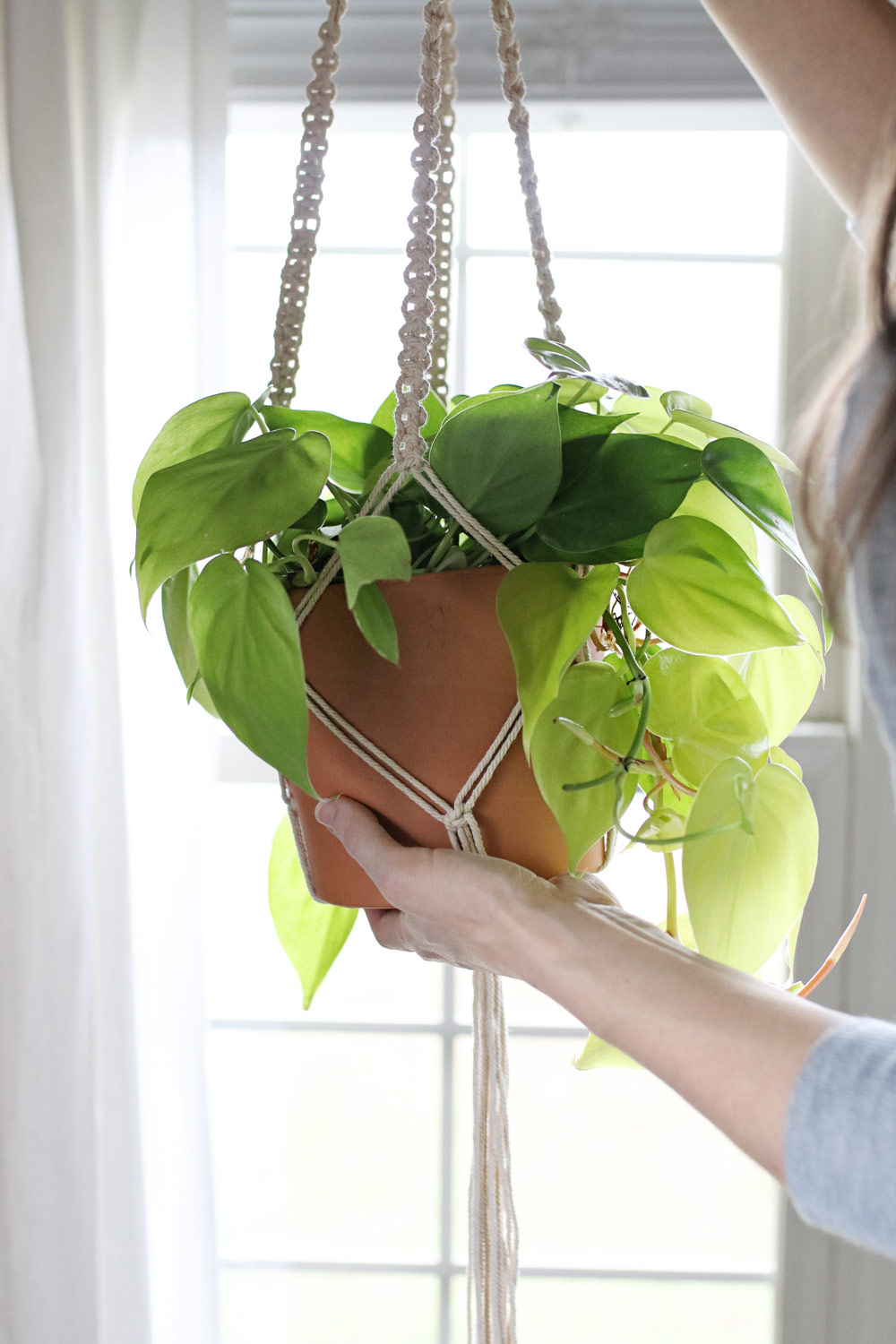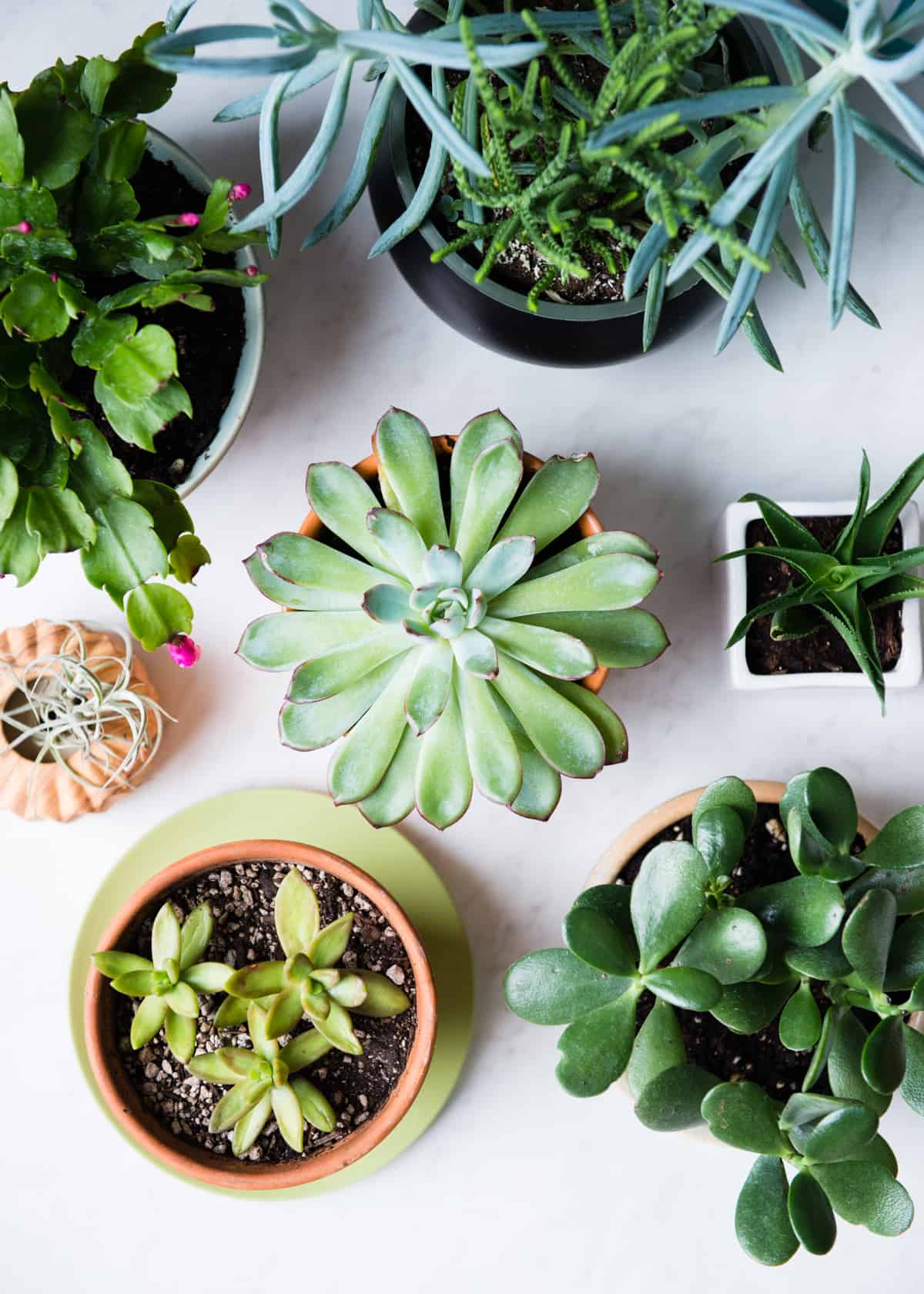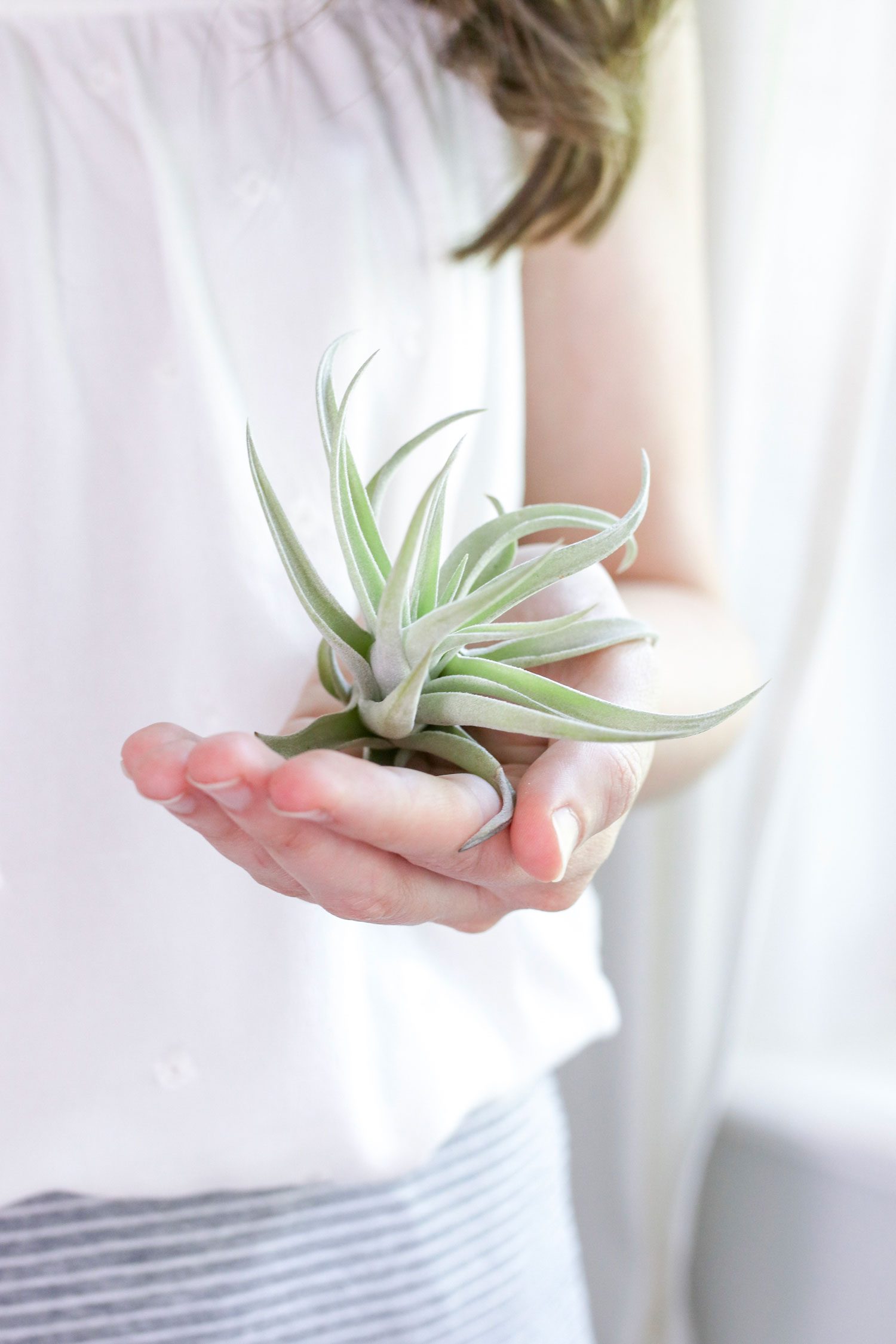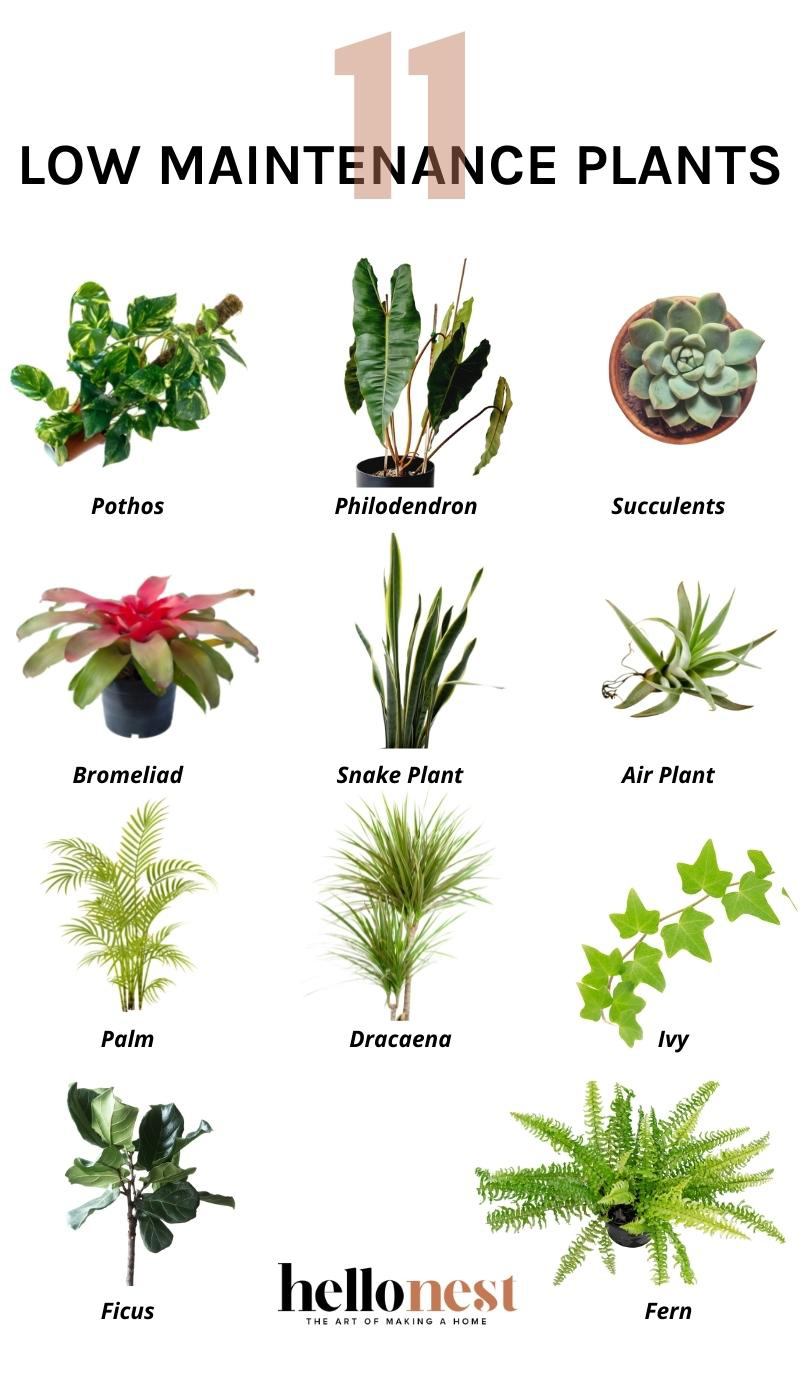Whether you’re just starting out as an indoor plant enthusiast, have a poor track record for keeping them alive, or have been led to believe that you are just too distracted or busy to keep your greens green, this one’s for you. We’ve put together a list of our favorite easy peasy low maintenance houseplants that not only require minimal skill, but help to filter the air and bring some freshness and vibrancy into your space. Bright light, low light, or dry conditions? Trust us, there’s a plant for that!
The Best Low-Maintenance Houseplants

Pothos
One of our favourite easy to find and manage plants is pothos. It’s a fabulous choice for any room in your home that could use some leafy greens, no matter how minimal the light which makes them perfect for darker hallways, bathrooms, or office spaces. They do like indirect sunlight and will need access to that for growth, but they’ll stay alive (just smaller!) with much less.
Keep pothos in soil, watering when the top few inches have dried down, or…keep it in water! If you prefer to grow in a vase, take a cutting from the larger pothos, and place in fresh water. Note that this plant is toxic to kids, cats, and dogs when ingested (source).
Philodendron
The philodendron looks deceivingly similar to the pothos (so much so that they are often mistaken); while still a low maintenance houseplant, the philodendron does require a bit more water and light than pothos. If you have a brighter room (with indirect sunlight), a philodendron will thrive there.
Simply water every 1-2 weeks (be sure the top inch has dried out between waterings), and offer them a stake to climb when they start to grow outwards. Like pothos, this plant will filter the air, and is also toxic to kids and pets (source).
Succulents
Succulents are a category of plants that have plump leaves which store water. Whether you like the look of jades, clusters of hens & chicks, or the ever-useful aloe vera, succulents are low-maintenance houseplants everyone can enjoy.
They enjoy bright indirect light (though you can eventually move them into direct sunlight if you gradually increase their exposure so that they don’t burn), and need to be planted in a special well-draining soil meant for succulents.
This drainage is really important as they are prone to rotting, so it’s also a good idea to use clay pots so that water evaporates evenly; let the top 2 inches of soil dry down between waterings, and be sure you never leave the pot sitting in water. If it drops leaves prematurely or you notice the leaves looking soggy or puckering, there’s too much moisture (source).
Bromeliad
If you’re searching for something bright, colorful, and tropical that can survive under most light conditions, why not opt for a bromeliad? While it prefers medium to bright indirect sunlight, it will do okay in dimmer rooms or even under fluorescent light.
It likes humidity, so kitchens and bathrooms are good spots that won’t require you to manage moisture levels. Plant in well-draining soil, and while it likes water, be careful not to overdo it. Check to see that the top inch has tried out, and water the soil and pour some into the cup of the leaves as well (source).
Snake plant
What is not to love about the snake plant? It’s easy, resilient, and looks great in any room. It thrives in bright indirect sunlight and needs it to get its grow on, but if all you’ve got is lower light, it will make do by staying small. This is a great choice if you’re also looking for added air filtration, just be sure to dust off the leaves so they can breathe.
Snake plants like drier soil, so you’ll want to see at least a two-inch dry-down before watering, and if it starts to droop, water it even less.
Air plant
These cute little spindly plants are perfect for perching on a shelf of books, setting on a mantle, or showcasing in a hanging glass terrarium; light and delicate, they bring the desert vibes without having to deal with any soil at all. Make no mistake, though, they still need water!
Every 1-2 weeks, set your air plant in a bowl of lukewarm water for about five minutes, then shake it dry. You can also mist it occasionally if you notice the leaves beginning to get crispy at the ends (limp or mushy means too much water!) They like bright, indirect sunlight, but full-spectrum fluorescent light is okay too (source).
Palm
The quickest way to transform your space into a tropical-feeling paradise is to get yourself a palm. They can grow in indirect sunlight or low light, and if you are one of those people who enjoy watering your plants because they offer you a sense of involvement, a palm is a good choice.
They are easy, but like moist well-draining soil, so this means watering 2-3 times per week depending on the conditions, the amount of light, and the season. All plants need a bit more water in brighter-light growing seasons. Use a clay pot as they allow water to evaporate evenly from the soil, preventing the root ball from rotting (source).
Dracaena
There are a few different varietals of dracaena–while some have wide, flat leaves, others look more like yucca or palm trees. They will tolerate lower light but prefer medium to bright indirect sun, and are perfect plants for your home or office—anything with average temperatures, light, and moisture.
Water it weekly during the growing season, a bit less in winter. It’s also helpful with air filtration, though note that this one is toxic to dogs and cats when ingested (source).
Ivy
If you’ve got a small windowsill or shelf that can’t accommodate a larger potted plant, ivy is perfect. It loves bright light and needs it for its variegation and growth, but if you’ve got a low light spot, you’ll find it will manage okay, but the leaves will lose any ornamental detail and turn to solid green.
Let your ivy dry down an inch between waterings, and remember to occasionally dust off the leaves (source).
Ficus
There’s such a wide variety of ficus plants that you could have a room full, each looking completely different. From the fiddle-leaf fig to the rubber plant, these are robust, hardy plants. Set them in a spot with bright indirect sun, and let the soil dry down 1-2 inches between waterings.
These stunners can grow quite large, so it’s best to rotate them occasionally so that they grow upright and the whole plant gets some access to the light. Note that ficus is also toxic to kids and pets when ingested (source).
Fern
Sometimes we want plants that look spindly, tall, or spiky, but if you’re more keen on something that’s full of foliage, look no further than the abundantly verdant fern. They are low to medium light tolerant, but like many of the others, prefer bright indirect sun.
They need well-draining soil and moisture, so it’s time to water when the top inch has dried down. An occasional misting is helpful if you want to encourage new growth, or if you prefer, simply keep it in a room that has naturally higher humidity, such as the kitchen or the bathroom.
Rules for Plant Newbies
Plan plants around light
Start by considering where you’d want to put your plant, and depending on the quality of light that’s available, shop from there. No matter your skill level or less-than-green-thumb past, believe that it is possible to have a home filled with beautiful foliage without too much fussing and fretting.
Read labels
No matter which low-maintenance houseplants you choose, it’s always advisable to read the little care label that comes with it so that can confirm it’s in the right soil and light levels from the get-go. Never leave your plants sitting in stagnant water as this can lead to root rot and weaken the plant, which makes it more susceptible to disease and pests.
General plant rules
Fertilizers are only needed occasionally, and even then, only during a plant’s growing season (which in the northern hemisphere is spring and summer.) Always purchase the fertilizer type meant for your plant, and follow the instructions on the label so that you aren’t overfeeding. Keep your plants in average temperatures, and away from extremes such as drafty windows or heaters.
To water or not to water?
Lastly, a general rule of thumb is that if leaves are yellowing, droopy, or smell moldy, it’s a sign of too much water, while browning leaves and crispy edges (and visibly crumbly dry soil) is a sign it needs more.
1


Leave a Reply